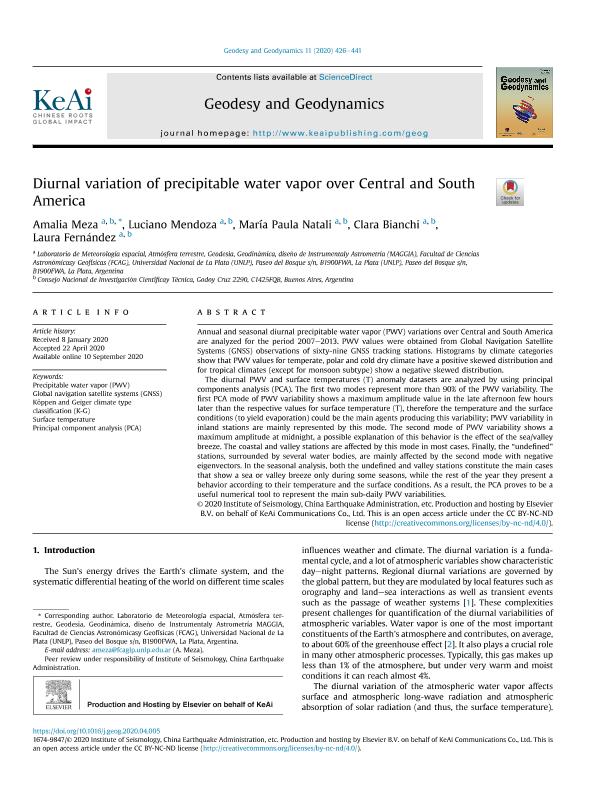Artículo
Diurnal variation of precipitable water vapor over Central and South America
Meza, Amalia Margarita ; Mendoza, Luciano Pedro Oscar
; Mendoza, Luciano Pedro Oscar ; Natali, Maria Paula
; Natali, Maria Paula ; Bianchi, Clara Eugenia
; Bianchi, Clara Eugenia ; Fernandez, Laura Isabel
; Fernandez, Laura Isabel
 ; Mendoza, Luciano Pedro Oscar
; Mendoza, Luciano Pedro Oscar ; Natali, Maria Paula
; Natali, Maria Paula ; Bianchi, Clara Eugenia
; Bianchi, Clara Eugenia ; Fernandez, Laura Isabel
; Fernandez, Laura Isabel
Fecha de publicación:
11/2020
Editorial:
KeAi Communications Co.
Revista:
Geodesy and Geodynamics
ISSN:
1674-9847
Idioma:
Inglés
Tipo de recurso:
Artículo publicado
Clasificación temática:
Resumen
Annual and seasonal diurnal precipitable water vapor (PWV) variations over Central and South America are analyzed for the period 2007–2013. PWV values were obtained from Global Navigation Satellite Systems (GNSS) observations of sixty-nine GNSS tracking stations. Histograms by climate categories show that PWV values for temperate, polar and cold dry climate have a positive skewed distribution and for tropical climates (except for monsoon subtype) show a negative skewed distribution. The diurnal PWV and surface temperatures (T) anomaly datasets are analyzed by using principal components analysis (PCA). The first two modes represent more than 90% of the PWV variability. The first PCA mode of PWV variability shows a maximum amplitude value in the late afternoon few hours later than the respective values for surface temperature (T), therefore the temperature and the surface conditions (to yield evaporation) could be the main agents producing this variability; PWV variability in inland stations are mainly represented by this mode. The second mode of PWV variability shows a maximum amplitude at midnight, a possible explanation of this behavior is the effect of the sea/valley breeze. The coastal and valley stations are affected by this mode in most cases. Finally, the “undefined” stations, surrounded by several water bodies, are mainly affected by the second mode with negative eigenvectors. In the seasonal analysis, both the undefined and valley stations constitute the main cases that show a sea or valley breeze only during some seasons, while the rest of the year they present a behavior according to their temperature and the surface conditions. As a result, the PCA proves to be a useful numerical tool to represent the main sub-daily PWV variabilities.
Archivos asociados
Licencia
Identificadores
Colecciones
Articulos(CCT - LA PLATA)
Articulos de CTRO.CIENTIFICO TECNOL.CONICET - LA PLATA
Articulos de CTRO.CIENTIFICO TECNOL.CONICET - LA PLATA
Citación
Meza, Amalia Margarita; Mendoza, Luciano Pedro Oscar; Natali, Maria Paula; Bianchi, Clara Eugenia; Fernandez, Laura Isabel; Diurnal variation of precipitable water vapor over Central and South America; KeAi Communications Co.; Geodesy and Geodynamics; 11; 6; 11-2020; 426-441
Compartir
Altmétricas



